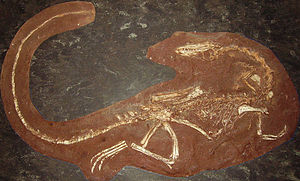Neotheropoda
| Neotheropoda | ||||||||||||
|---|---|---|---|---|---|---|---|---|---|---|---|---|

Skeleton of Coelophysis , one of the earliest neotheropods, in London's Natural History Museum . |
||||||||||||
| Temporal occurrence | ||||||||||||
| Upper Triassic to Upper Cretaceous (birds to the present) | ||||||||||||
| 228 to 65.5 (or 0) million years | ||||||||||||
| Locations | ||||||||||||
|
||||||||||||
| Systematics | ||||||||||||
|
||||||||||||
| Scientific name | ||||||||||||
| Neotheropoda | ||||||||||||
| Bakker , 1986 |
The Neotheropoda are a group within the theropod dinosaurs . It includes all of the more advanced Theropoda including the Ceratosauria and the Tetanurae , but excludes some very primitive forms such as the Eoraptor and the Herrerasauridae . These very original forms lack many of the bird-like features that characterize the Neotheropoda.
It is controversial which of these original forms can actually be classified within the Theropoda: For example, Langer (2004) sees Guabeisaurus as the only form that can be assigned to the Theropoda, but is outside the Neotheropoda, while forms such as Eoraptor and the Herrerasauridae are outside classified the theropoda. Sereno (1999), however, classifies Eoraptor and the Herrerasauridae within the Theropoda and outside the Neotheropoda.
This article deals with the taxon Neotheropoda from a phylogenetic point of view - for further information on the characteristics and biology of these animals see the main article Theropoda .
Chronological order
The oldest Neotheropoda come from the late Carnian (Upper Triassic, 228 million years ago) and include, for example, Coelophysis bauri . Since today's birds descend from neotheropod dinosaurs, from a phylogenetic point of view , the neotheropods include birds. The last of the non-avian neotheropods died out in mass extinction at the Cretaceous-Tertiary boundary about 65.5 million years ago.
Definition and synapomorphies
The taxon Neotheropoda was established in 1986 by Robert Bakker . It is defined as node-based taxon ( node-based definition ), the last common ancestor of Coelophysis bauri and registration domesticus ( house Sperling including) and all descendants of this ancestor with.
The Neotheropoda can be distinguished from more original forms by numerous commonly derived features ( synapomorphies ). Examples are the tearbone (lacrimale), which appears over a large area on the top of the skull, and the sacrum, which consists of 5 sacral vertebrae. The second finger is the longest of the hand, and the penultimate phalanx (not counting the claw) is the longest.
Systematics
The following is a current example of a cladogram, simplified according to Nesbitt and colleagues (2009):
| Theropoda |
|
||||||||||||||||||||||||||||||
|
|
Individual evidence
- ^ Gregory S. Paul : Dinosaurs of the Air. The Evolution and Loss of Flight in Dinosaurs and Birds. The Johns Hopkins University Press, Baltimore MD et al. 2002, ISBN 0-8018-6763-0 , p. 25.
- ^ Max C. Langer, Martin D. Ezcurra, Jonathas S. Bittencourt, Fernando E. Novas : The origin and early evolution of dinosaurs. In: Biological Reviews. Vol. 85, No. 1, 2010, ISSN 1464-7931 , pp. 55-110, doi : 10.1111 / j.1469-185X.2009.00094.x .
- ^ A b Paul Sereno: Neotheropoda. (No longer available online.) In: Taxon Search. Archived from the original on May 16, 2012 ; Retrieved May 15, 2011 . Info: The archive link was inserted automatically and has not yet been checked. Please check the original and archive link according to the instructions and then remove this notice.
- ↑ Thomas R. Holtz Jr .: A new phylogeny of the Carnivorous Dinosaurs. In: Gaia. Revista de Geociências. Vol. 15, 1998, ISSN 0871-5424 , pp. 5-61.
- ↑ Sterling J. Nesbitt, Nathan D. Smith, Randall B. Irmis, Alan H. Turner, Alex Downs, Mark A. Norell : A Complete Skeleton of a Late Triassic Saurischian and the Early Evolution of Dinosaurs. In: Science . Vol. 326, No. 5959, 2009, pp. 1530–1533, doi : 10.1126 / science.1180350 , digital version (PDF; 2.78 MB) .